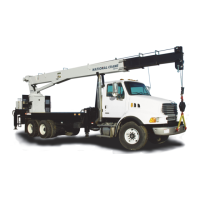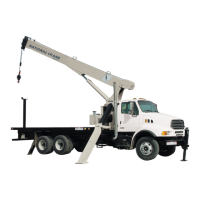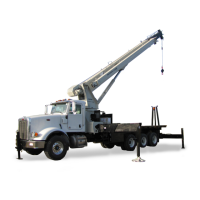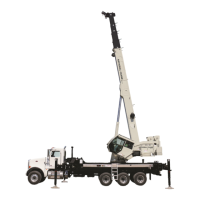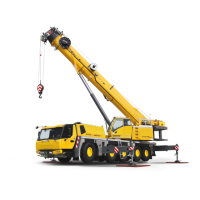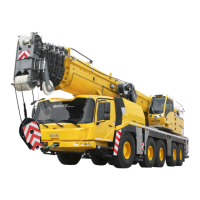2-5
• Check that the display of the main boom length
agrees with the actual boom length.
• Check that the display of the main boom angle
agrees with the actual boom angles.
• Check that the display of the operating radius of
the crane agrees with the actual radius.
• Check the load display by lifting a load of known
weight. The accuracy of the load indication shall
be within the tolerance of SAE J159.
$
After being properly checked, the LMI is operational.
The operator shall be thoroughly familiar with all con-
trols of the LMI and he shall properly set the reeving
Switch before operating the crane. The proper function
of the system shall be checked by lifting a load of known
weight and comparing the load to the information dis-
played on the LMI.
Rated loads include the weight of the hook block,
slings, and auxiliary load handling devices. Their com-
bined weights shall be subtracted from the listed load
capacities as stated on the load capacity chart to obtain
the net load to be lifted.
3)3$&%)3$%#$5$4
%)%%$'#';'$&@%7
#$$#&5%33$&
)$6#3$3$&?!57
$8
)$'$'6%3$&$$&
&9'#3$3$&?!
5$8
&!44$&$4&4&%
%#%'5'$44$&56
'3'$$$'$$86'
4&%%#%4&$&
56$)K%$&%$)
''%6$$&4&%%8
4)#$&%)3$&%$
53$%8
2,
Always seek the best possible work site when park-
ing the crane. An ideal parking location at a job site is
firm, level, dry ground or pavement located in close prox-
imity to the work station. Avoid uneven, rocky or muddy
terrain, steep grades or locations with unnecessary over-
head obstructions. Location should be selected such
that outriggers can be fully extended and leg comes
down on firm level surface. Particular care must be
taken in selecting a site position to the location of over-
head power lines so that proper clearance conditions
can be maintained. Ideally, one should select a location
at which the boom could not come within minimum rec-
ommended distance of the power lines at full extension.
It is best to select a location on the site such that
most of the lifting can be done over the outrigger sup-
port or rear of the truck.
"+
1. Position the truck so that the outriggers can be
extended without encountering obstructions. Set
the truck park brake securely and turn front
wheels into the curb. Wheel chocks may be
required under certain conditions.
2. With the gear shift in neutral, depress clutch (if
equipped with a manual transmission), and en-
gage the power takeoff by pulling out the shifting
knob.
3. Bring the hydraulic system up to operating tem-
perature (oil reservoir warm to the touch) by al-
lowing the system to operate by actuating the
outrigger retract switch with all outriggers fully
retracted.
$$$&56'$'$
K$%%%$#%36'$8
If operating on sloping ground provide blocks. When
lifting is to be done on soft terrain or hot asphalt, sup-
port the outrigger and stabilizer pads with bearing pads.
Some concrete and asphalt surfaces are relatively thin
and cannot support outrigger or stabilizer loading. Con-
crete can break through and cause instability.
Variation in chassis, outrigger and mounting con-
figurations will cause outrigger foot loading to differ on
each crane, however, outrigger foot loads can be as
high as 50,000 pounds (22 697 kg) when outriggers are
at full span [154 psi (1.06 MPa) on standard outrigger
pads]. Support surface bearing capacities vary by a large
amount—from 833 psi (5.7 MPa) on bed rock down to
14 psi (0.1 MPa) on soft clay. Loose sand or soft as-
phalt will support even less load. It is imperative that
the operator take proper precautions to insure the
outrigger foot has adequate cribbing for existing soil
conditions.
"
!
"
!
"
!
"
!
Reference Only
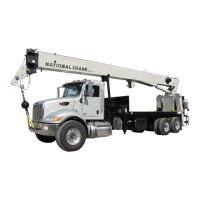
